
The Pellissier Building and adjoining Wiltern Theatre is a 12-story, 155-foot (47 m) Art Deco landmark at the corner of Wilshire Boulevard and Western Avenue in Los Angeles, California. The entire complex is commonly referred to as the Wiltern Center. Clad in a blue-green glazed architectural terra-cotta tile and situated diagonal to the street corner, the complex is considered one of the finest examples of Art Deco architecture in the United States. The Wiltern building is owned privately, and the Wiltern Theatre is operated by Live Nation's Los Angeles division.

The Midland Theatre, known officially for sponsorship purposes as Arvest Bank Theatre at the Midland, is a 3,200-seat theater located in the Power & Light District of Kansas City, Missouri, United States. The National Collegiate Athletic Association under Walter Byers had its headquarters in the building from the 1950s until it moved to 6299 Nall Avenue at Shawnee Mission Parkway in Mission, Kansas in 1971. The theatre was originally known as the Loew's Midland Theatre until 1961. Over the years, the theatre has been known by various names including: Saxon Theatre, Midland Stadium, Midland 1-2-3 Theatre, Midland Theatre and The Midland by AMC.

The Michigan Theatre at 124 North Mechanic Street in Jackson, Michigan opened in 1930 and was designed by Maurice Herman Finkel. It was listed on the National Register of Historic Places on May 8, 1980, and is undergoing renovations as of 2005.
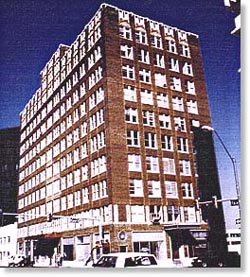
The Dermon Building is a historic building in Memphis, Tennessee, listed on the National Register of Historic Places. It was constructed in 1925 by Dave Dermon at a cost of around $800,000. From the time it was constructed, until 1983, it was the home of Dave Dermon Company, and Dave Dermon Insurance. 'Papa' sold the building in the 1930s, and although it has changed hands many times, it is still known as the Dermon Building today.
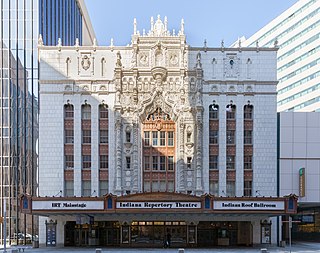
The Indiana Theatre is a multiple use performing arts venue located at 140 W. Washington Street in Indianapolis, Indiana. It was built as a movie palace and ballroom in 1927 and today is the home of the Indiana Repertory Theatre. It was added to the U.S. National Register of Historic Places in 1979. It is located in the Washington Street-Monument Circle Historic District.

Morris Performing Arts Center is a 2,564-seat concert hall located in South Bend, Indiana. It opened in 1922 as a vaudeville house and later became a movie palace. It was developed along with the neighboring Palais Royale Building by the Palace Theater Corporation. It is a four- to five-story, rectangular, Spanish Renaissance Revival style brick building with finely crafted terra cotta ornamentation. It was planned for demolition in 1959 but was saved from demolition, and between 1998 and 2000, it was restored and remodeled.
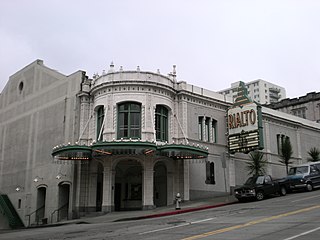
The Rialto Theatre in Tacoma, Washington was built in 1918 to showcase movies. Its design reflects the affluence following World War I. It reflects the character of a palace and is the result of efforts by entrepreneur Henry T. Moore and Tacoma architect Roland E. Borhek. Designed to hold 1500 patrons and retail space. The two-and-a-half-story structure is in the historic downtown of Tacoma. The area has long been associated with theaters and entertainment. The theater is freestanding, with a dramatic view on an incline with a classical façade sheathed of glazed white terra cotta. Both the interior and exterior retain most of the original design of Roland E. Borhek. The theater has an auditorium, proscenium with stage, a relocated projection booth, balcony, lobby, and commercial space. It has been altered with the removal of the storefronts and marquee. On the inside, the lobby's decorative ceiling has been hidden and the concession areas expanded.

The Arctic Club Building is a nine-story hotel in Seattle, Washington located at the Northeast corner of Third Avenue and Cherry Street. Built in 1916 for the Arctic Club, a social group established by wealthy individuals who experienced Alaska's gold rush, it was occupied by them from construction until the club's dissolution in 1971. It is entirely faced with cream white terra cotta with submarine blue and orange-brown accents. It has terra cotta walrus-heads lining the third floor of the building and was also adorned with a polar bear. It is one of the finest examples of multi-colored matte glaze terra cotta work in the city. Recently restored, the building has been adapted for use as a luxury hotel, Arctic Club Seattle. A roof garden used by the social club was replaced with a penthouse office suite.

The Kahl Building is an historic building located in Downtown Davenport, Iowa, United States. It was listed on the National Register of Historic Places in 1983. In 2020 it was included as a contributing property in the Davenport Downtown Commercial Historic District. The building also includes the Capitol Theatre.

The Mississippi Lofts and Adler Theatre is an apartment building and theater complex located in downtown Davenport, Iowa, United States. It is individually listed on the National Register of Historic Places by its original name, the Hotel Mississippi and RKO Orpheum Theater. The Hotel Mississippi was listed on the Davenport Register of Historic Properties in 2005. In 2020 the complex was included as a contributing property in the Davenport Downtown Commercial Historic District.

Circa 21 Dinner Playhouse, Formerly known as The fort Armstrong theater, is an historic building located in downtown Rock Island, Illinois, United States. It opened in 1920 and it was individually listed on the National Register of Historic Places in 1980. In 2020 it was included as a contributing property in the Downtown Rock Island Historic District. It was commonly referred to as the Fort Theater. The theater was named for Fort Armstrong, a fortification that sat in the middle of the Mississippi River near the present location of the Rock Island Arsenal. Its Waitstaff, The Bootleggers, are 1 of just 2 performing Waitstaffs in the USA

The Kress Building is a historic commercial building at 210 West Main Street in Blytheville, Arkansas. It is a two-story concrete and steel structure, faced in brick and terra cotta. Built in 1938, it was one of the first buildings in the city to be built using steel framing, and is one of its finest Art Deco structures. The first floor areas are faced in terra cotta, while the second floor is predominantly cream-colored brick. Windows on the second floor are surrounded by ivory terra cotta incised with fluting and shell patterns.

The Criterion Theatre is a historic performance space at 35 Cottage Street in downtown Bar Harbor, Maine. Built in 1932 when Bar Harbor's summer scene was at its height, it is one of only two Art Deco theaters in the state of Maine. The theatre has in recent years struggled for financial solvency but was purchased in 2014 by a nonprofit organization. After a major renovation, the theater reopened for business in May 2015. It was listed on the National Register of Historic Places in 1980.

The Pantages Theatre or Jones Building in Tacoma, Washington was designed by the architect B. Marcus Priteca. The unusual structure opened in January 1918. It was designed to be an office building and a vaudeville theatre. The theaters Second Renaissance Revival style is juxtaposed with the Commercial style. The exterior above the ground floor is largely unaltered. The building still houses entertainment and commercial activities.

Blackstone-State Theater is a historic theatre building located at South Bend, St. Joseph County, Indiana. It was built in 1919, and is a four-story, Classical Revival style brick and terra cotta building. The first floor has four storefronts and the theatre entrance. The upper floors form a loggia that rises to the fourth floor and supported by four pairs of fluted columns. The theater originally sat 2,500 patrons.

The Downtown Ponca City Historic District is a 73 acres (30 ha) area of historic buildings in Ponca City, Oklahoma. The historic district is listed on the National Register of Historic Places in 2011.
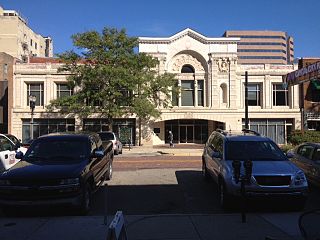
The Strand Theatre and Arcade, also known as the Michigan Theatre and Arcade, is a former theatre building located at 211–219 South Washington Avenue in Lansing, Michigan. It was listed on the National Register of Historic Places in 1980.
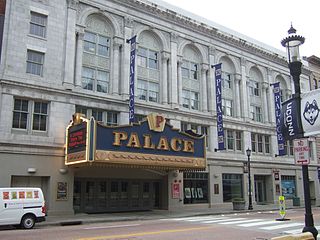
The Palace Theater is a 2,900-seat auditorium at 100 East Main Street in downtown Waterbury, Connecticut. The theater currently presents a variety of live entertainment, hosting traveling productions and locally produced events. It was built in 1921 to a Renaissance Revival design by Thomas W. Lamb, and is an architecturally prominent element of the city's downtown. It underwent a major restoration in the early 21st century, and is listed on the National Register of Historic Places.

The Rialto Theater in Loveland, Colorado, at 228-230 E. Fourth Ave., was built in 1919. It was listed on the National Register of Historic Places in 1988.

The Orpheum Theater, formerly the Sioux Falls Community Playhouse, is a historic theater at 315 North Phillips Avenue in downtown Sioux Falls, South Dakota. It is the oldest theater in Sioux Falls and was listed on the National Register of Historic Places in 1983. Originally, it hosted vaudeville performances, and briefly served as a movie theater before being converted again into a stage theater, which it remains today.























